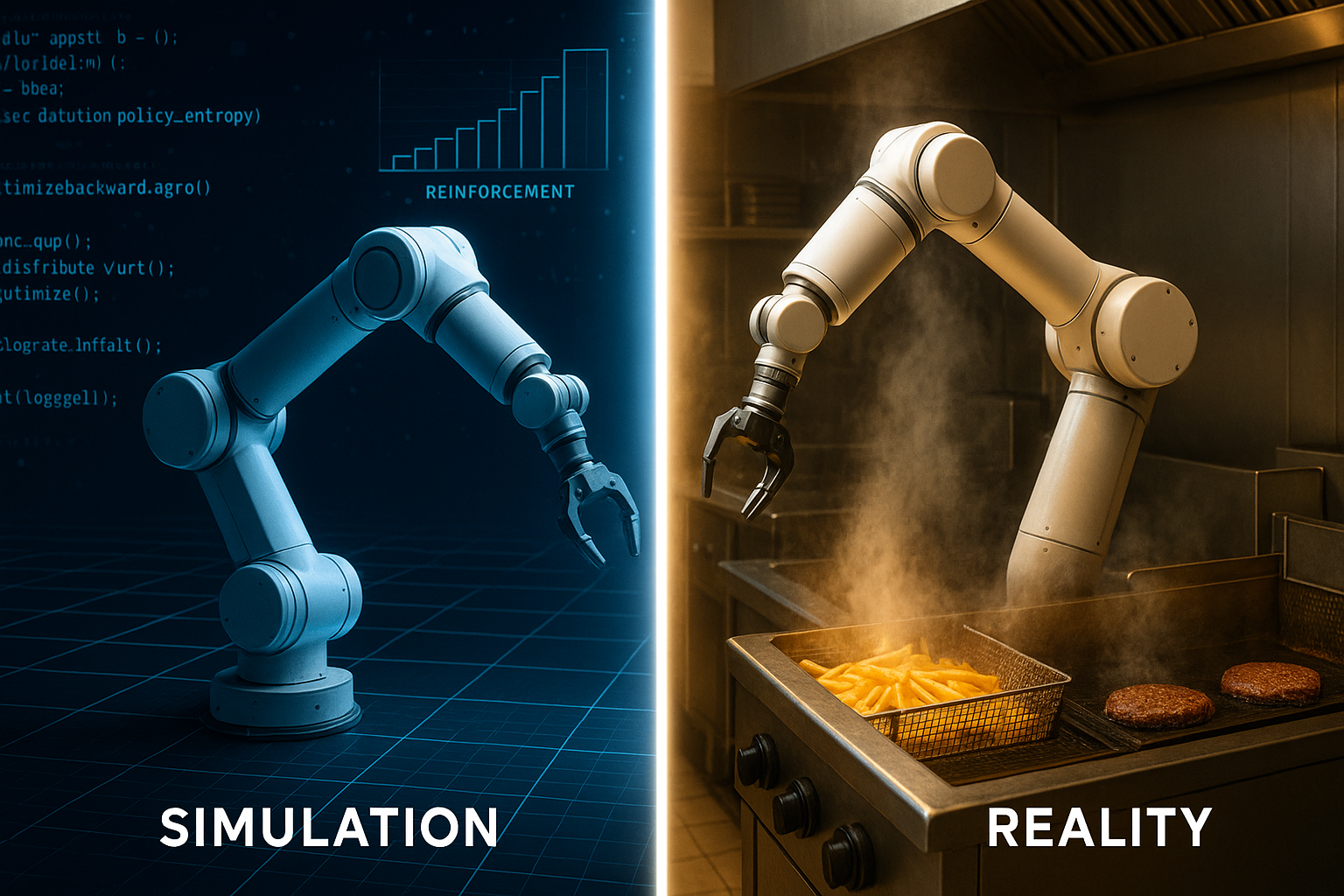Automation is the driving force behind the new era of dining. Forget the slow, clumsy robotic arms of the past; we are entering the age of fully autonomous kitchens, capable of managing frying, grilling, prep, and custom order fulfillment. From concepts like CaliExpress by Flippy to integrated systems from Chefee Robotics, robotics now requires a method to learn and adapt to the complexity of the real world, where food and ingredients are inherently variable.
This is where Sim-to-Real technology and Digital Twins come into play. These simulation tools have become the backbone of the next generation of robot chefs. They allow developers to build, test, and refine AI algorithms in a perfect virtual environment before deploying them into the chaos of a commercial kitchen.
Digital Twins: The Training Ground for Robot Chefs
A Digital Twin of a robotic kitchen is an extremely accurate, virtual replica of the real robot and its working environment.

Simulation enables fast, safe, and targeted training for the specific needs of fast-food operations:
- Scalable Reinforcement Learning: A robot like Flippy (Miso Robotics) is trained in the digital twin on millions of iterations of tasks (flipping burgers, plunging fries). This allows for rapid learning without risking damage to physical equipment or wasting ingredients.
- Handling Edge Cases: In the real kitchen, ingredients are inconsistent, oil temperature varies, and equipment might be slightly misaligned. The simulator exposes the robot to thousands of unforeseen scenarios (edge cases) so the AI learns to react reliably and consistently.
- Deployment and Scaling: Once the behavior is mastered in simulation, the Sim-to-Real process transfers the code to the physical robot, guaranteeing consistent performance across hundreds of locations (like White Castle).
Bridging The Sim-to-Real Gap (The Reality Gap)
The main challenge remains the **Sim-to-Real Gap** (*The Reality Gap*), the inherent difference between the physics of the simulated world and the complex, unpredictable physics of the real world. Researchers are addressing this through new training techniques:
- Synthetic Data for AI: The simulator generates **synthetic data** (e.g., virtual images of fries) to train the robot's computer vision system to identify food without requiring massive collection of real-world images.
- Domain Randomization: To make the robot more robust, developers deliberately **randomize** the simulation: varying food texture, kitchen lighting, camera angle, and physical properties (friction, weight) of objects. This forces the AI to generalize its behavior.
- Embodied Learning: Systems like Chefee, which handle fresh ingredients, focus on tight feedback loops between the simulator and the physical robot to teach dexterity (force, speed, finesse) for complex movements like stirring or precise seasoning.
Impact: The Kitchen of the Future is Now
This convergence of *Sim-to-Real* and AI has an immediate impact on the restaurant sector. Automation relieves human staff of **repetitive, time-consuming, and dangerous tasks** (like frying), allowing employees to focus on customer service and management.
It addresses major industry challenges: **labor shortages**, **controlling labor costs**, and **reducing food waste** through precise portioning and better inventory management. The ability to analyze customer data enables **extreme menu personalization** (catering to allergies, specific diets) and increased **traceability**.
The path to full kitchen automation is a team effort, led by the algorithms in the **Digital Twins** that learn, adapt, and transfer virtual perfection into our real-world kitchens. This is the essence of the **Sim-to-Real Revolution**.
